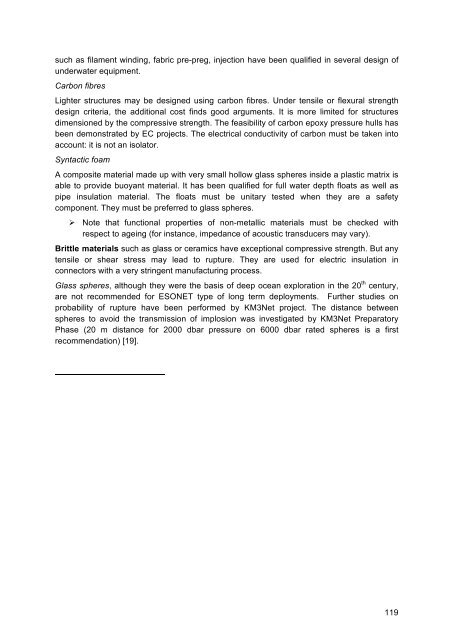Handbook of best practices
Handbook%20of%20best%20practices
Handbook%20of%20best%20practices
Create successful ePaper yourself
Turn your PDF publications into a flip-book with our unique Google optimized e-Paper software.
such as filament winding, fabric pre-preg, injection have been qualified in several design <strong>of</strong><br />
underwater equipment.<br />
Carbon fibres<br />
Lighter structures may be designed using carbon fibres. Under tensile or flexural strength<br />
design criteria, the additional cost finds good arguments. It is more limited for structures<br />
dimensioned by the compressive strength. The feasibility <strong>of</strong> carbon epoxy pressure hulls has<br />
been demonstrated by EC projects. The electrical conductivity <strong>of</strong> carbon must be taken into<br />
account: it is not an isolator.<br />
Syntactic foam<br />
A composite material made up with very small hollow glass spheres inside a plastic matrix is<br />
able to provide buoyant material. It has been qualified for full water depth floats as well as<br />
pipe insulation material. The floats must be unitary tested when they are a safety<br />
component. They must be preferred to glass spheres.<br />
Ø Note that functional properties <strong>of</strong> non-metallic materials must be checked with<br />
respect to ageing (for instance, impedance <strong>of</strong> acoustic transducers may vary).<br />
Brittle materials such as glass or ceramics have exceptional compressive strength. But any<br />
tensile or shear stress may lead to rupture. They are used for electric insulation in<br />
connectors with a very stringent manufacturing process.<br />
Glass spheres, although they were the basis <strong>of</strong> deep ocean exploration in the 20 th century,<br />
are not recommended for ESONET type <strong>of</strong> long term deployments. Further studies on<br />
probability <strong>of</strong> rupture have been performed by KM3Net project. The distance between<br />
spheres to avoid the transmission <strong>of</strong> implosion was investigated by KM3Net Preparatory<br />
Phase (20 m distance for 2000 dbar pressure on 6000 dbar rated spheres is a first<br />
recommendation) [19].<br />
119


